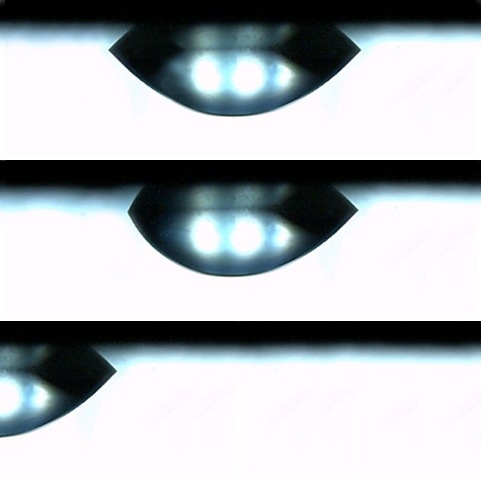Hanging Droplets Feel More Friction
Revised 2 December
According to high school textbooks, the force needed to slide a box across the floor increases with its weight. But for a liquid drop on a solid surface, that isn’t always true, reports a team in the 25 December Physical Review Letters. They measured the force needed to push a millimeter-sized droplet and found that a droplet hanging upside down from the surface required more force to get moving than a droplet resting on top of the surface. The result could help researchers identify which forces are responsible for pinning liquid droplets to different surfaces.
Sliding a heavy box requires more of a sideways force than a lighter box because at the microscopic level, the larger weight creates more contact area between the rough surfaces of the floor and the box. But when the sliding object is a liquid, the rules change. The stickiness is related to surface tension, and the role of the droplet’s weight isn’t as clear. Researchers have used inclined planes to measure the friction of sliding droplets, but in those experiments, when changing the tilt angle, both components of force change simultaneously. Researchers couldn’t independently control the forces parallel and perpendicular to the solid surface. A few researchers have worked with devices that rotate and use centrifugal force to push the droplet, but the technique lacked a good way to monitor the droplet in real time.
So chemical engineer Rafael Tadmor and his colleagues at Lamar University in Beaumont, Texas put a small, wireless video camera next to their droplet stage inside an enclosed chamber at the end of a one-meter-long, rotating arm. The team placed droplets of oil a few microliters in volume on a slick, horizontal surface such as Teflon and noted the rotational speed (and therefore the centrifugal force) at which they began to move.
By tilting the surface inward or outward and adjusting the rotational speed of the apparatus, they could vary the force perpendicular to the surface–the normal force–effectively changing the weight of droplets as felt by the solid surface. They could even cause the droplet to pull rather than push on the surface. Increasing the force toward the surface increased the force needed to slide the droplet, as would be expected for a solid object. But surprisingly, pulling away from the surface had the same effect: stronger pulling led to a stronger friction force.
Pulling the droplet away from the surface actually created slightly more of a frictional force than pushing it down by the same amount. In one comparison, the researchers placed droplets either on a horizontal surface or upside down hanging from the surface. They found that hanging droplets required 27 percent more centrifugal force to get moving than droplets resting on the surface.
Tadmor says the difference between upside down and right-side up droplets may have to do with molecules in the solid surface forming weak chemical interactions with the liquid molecules. At the ring (or contact line) along the outer edge of the droplet, surface tension pulls up on the molecules in the solid, which reorients them in a way that enhances the molecular interactions. Although gravity pressing down on a droplet increases its contact with the solid surface, in hanging droplets, gravity assists the molecular reorientation, leading to stronger interactions between solid and liquid, Tadmor says.
Molecular rearrangements probably aren’t the whole story, says Alidad Amirfazli, a mechanical engineer at the University of Alberta in Edmonton, Canada. ”I’d bet my bottom dollar” that some of the counter-intuitive results might be explained by considering variations in the angle at which the liquid surface meets the solid, which may result from tilting, he says. The same type of experiment could help researchers study the behavior of lubricants in zero gravity or the chemical properties of more complicated structures such as super water-repellant surfaces, says Miriam Rafailovich, a polymer physicist at the State University of New York in Stony Brook. “It’s a simple, elegant experiment that just about any lab can do on a tabletop,” she says.
–JR Minkel
JR Minkel is a freelance science writer in New York City.





